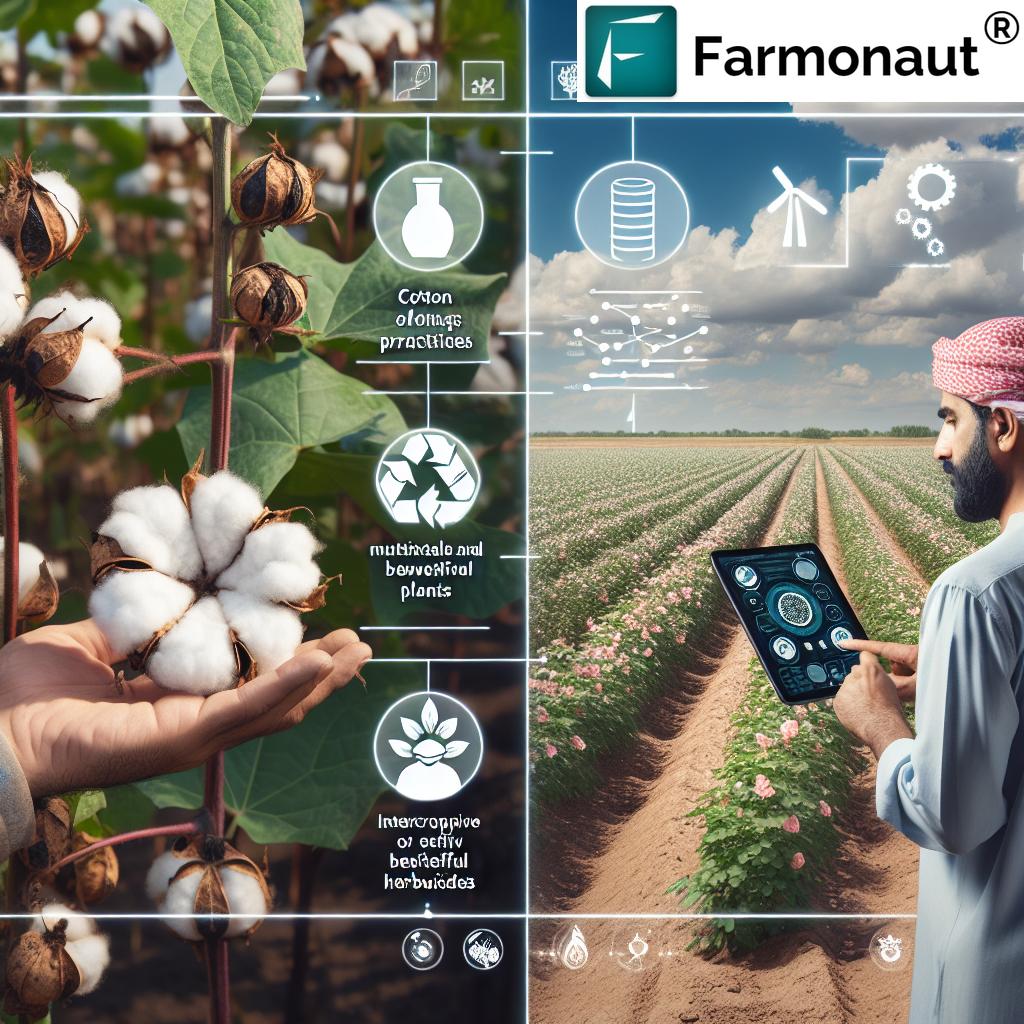Revolutionizing Texas Cotton Farming: Farmonaut’s Guide to Sustainable Agritech Solutions and Industry Trends
“Cotton breeding innovations have led to a 20% increase in yield potential over the last decade.”
“Texas produces approximately 25% of all cotton grown in the United States annually.”

Welcome to our comprehensive guide on revolutionizing Texas cotton farming through sustainable agritech solutions and industry trends. In this blog post, we’ll explore the latest advancements in cotton farming technology, agricultural sustainability practices, and the evolving landscape of the cotton industry. As we delve into this exciting topic, we’ll cover everything from innovative crop revenue assistance programs to groundbreaking herbicide registrations, and how these developments are shaping the future of cotton production in the Lone Star State.
The Evolution of Cotton Farming in Texas
Texas has long been at the forefront of cotton production in the United States, with its vast plains and favorable climate contributing to its status as a cotton powerhouse. However, the industry faces numerous challenges, including water scarcity, pest management, and the need for increased sustainability. To address these issues, farmers and researchers are turning to cutting-edge agritech solutions and innovative farming practices.
One such solution gaining traction among Texas cotton growers is Farmonaut’s precision agriculture platform. Farmonaut’s web application offers satellite-based crop monitoring, enabling farmers to make data-driven decisions about their cotton crops.

Crop Revenue Assistance Programs: A Lifeline for Cotton Farmers
In recent years, crop revenue assistance programs have become increasingly important for cotton farmers in Texas. These programs provide a safety net against market volatility and natural disasters, ensuring that farmers can continue to operate even in challenging times. Let’s explore some of the key programs available to cotton growers:
- Price Loss Coverage (PLC): This program offers payments when the effective price of cotton falls below a reference price set by the USDA.
- Agriculture Risk Coverage (ARC): ARC provides revenue loss coverage at the county or individual farm level.
- Crop Insurance: Various insurance options are available to protect against yield losses and revenue shortfalls.
These programs, combined with innovative agritech solutions like those offered by Farmonaut, are helping to stabilize the cotton industry and promote sustainable farming practices.
Herbicide Registration for Cotton: Balancing Efficacy and Environmental Concerns
The registration of new herbicides for cotton production is a critical process that involves balancing the need for effective weed control with environmental and health considerations. Recent developments in herbicide registration have focused on products that offer improved weed control while minimizing the potential for off-target movement and environmental impact.
One notable example is the recent registration of new formulations of dicamba for use in dicamba-tolerant cotton. These registrations come with strict application requirements to address concerns about drift and volatilization. Farmers using these products must follow specific guidelines regarding spray nozzles, buffer zones, and application timing to mitigate risks to non-target plants.
Cotton Breeding Innovations: Paving the Way for Higher Yields and Resilience
Cotton breeding innovations have been instrumental in advancing the productivity and sustainability of cotton farming in Texas. Breeders are focusing on developing varieties that offer:
- Improved yield potential
- Enhanced fiber quality
- Drought tolerance
- Pest and disease resistance
- Herbicide tolerance
These advancements are achieved through a combination of traditional breeding techniques and modern biotechnology. For instance, marker-assisted selection allows breeders to identify desirable traits more quickly and accurately, accelerating the development of new cotton varieties.
Farmonaut’s satellite-based crop monitoring can play a crucial role in evaluating the performance of these new cotton varieties across different fields and growing conditions. By providing real-time data on crop health and growth patterns, Farmonaut helps breeders and farmers alike in assessing the success of breeding programs.

Weed Control Strategies in Cotton Production
Effective weed management is crucial for maximizing cotton yields and quality. Texas cotton farmers are adopting integrated weed management strategies that combine chemical, cultural, and mechanical control methods. Some key approaches include:
- Crop Rotation: Alternating cotton with other crops helps break weed cycles and reduces the buildup of herbicide-resistant weed populations.
- Cover Crops: Planting cover crops between cotton seasons can suppress weeds and improve soil health.
- Precision Herbicide Application: Using GPS-guided sprayers and variable-rate technology allows for more targeted and efficient herbicide use.
- Mechanical Cultivation: Timely cultivation can effectively control weeds while reducing reliance on chemical herbicides.
Farmonaut’s precision agriculture tools can assist farmers in implementing these strategies by providing detailed field mapping and crop health data. This information enables growers to make informed decisions about when and where to apply weed control measures, optimizing resource use and minimizing environmental impact.
Sustainable Agriculture Techniques in Cotton Farming
Sustainability is becoming increasingly important in the cotton industry, with farmers, researchers, and agribusinesses working together to develop and implement environmentally friendly practices. Some key sustainable agriculture techniques being adopted in Texas cotton farming include:
- Conservation Tillage: Reducing soil disturbance helps prevent erosion and improve soil health.
- Precision Irrigation: Advanced irrigation systems and soil moisture sensors help optimize water use.
- Integrated Pest Management (IPM): Combining biological, cultural, and chemical control methods to manage pests more sustainably.
- Nutrient Management: Using soil testing and precision application techniques to optimize fertilizer use and reduce runoff.
Farmonaut’s satellite-based crop monitoring system plays a crucial role in supporting these sustainable practices. By providing real-time data on crop health, soil moisture, and other key parameters, Farmonaut enables farmers to make more precise decisions about resource allocation, reducing waste and environmental impact.

Cotton Quality Assessment: Ensuring Premium Fiber Production
The quality of cotton fiber is a critical factor in determining its value and end-use potential. Texas cotton farmers are increasingly focused on producing high-quality fiber to meet the demands of textile manufacturers and consumers. Key aspects of cotton quality assessment include:
- Fiber Length
- Strength
- Micronaire (fineness and maturity)
- Color Grade
- Trash Content
Advanced technologies, such as High Volume Instrument (HVI) testing, are used to evaluate these parameters quickly and accurately. This information helps farmers and buyers make informed decisions about cotton classification and pricing.
Farmonaut’s precision agriculture tools can contribute to improved cotton quality by helping farmers optimize growing conditions throughout the season. By monitoring factors such as soil moisture, plant stress, and growth patterns, farmers can make timely interventions to ensure the best possible fiber quality.
Agritech Solutions for Cotton Farmers: The Farmonaut Advantage
As we’ve discussed throughout this blog post, agritech solutions are playing an increasingly important role in revolutionizing Texas cotton farming. Farmonaut stands at the forefront of this technological revolution, offering a range of tools designed to optimize crop management and boost yields. Let’s explore some of the key features that make Farmonaut an invaluable resource for cotton farmers:
- Satellite-Based Crop Monitoring: Farmonaut’s platform uses multispectral satellite imagery to provide real-time insights into crop health, allowing farmers to detect issues early and take prompt action.
- AI-Powered Advisory System: The Jeevn AI system offers personalized recommendations based on crop conditions, weather forecasts, and historical data, helping farmers make informed decisions about irrigation, fertilization, and pest management.
- Weather Forecasting: Accurate, localized weather predictions enable farmers to plan their activities more effectively, reducing risks associated with adverse weather conditions.
- Resource Management Tools: Farmonaut’s platform helps farmers optimize the use of water, fertilizers, and other inputs, promoting sustainability and cost-efficiency.
By leveraging these advanced technologies, Texas cotton farmers can improve their productivity, reduce environmental impact, and stay competitive in an ever-evolving industry.
For developers and businesses interested in integrating Farmonaut’s powerful satellite and weather data into their own systems, the company offers a comprehensive API. Detailed documentation for the API can be found in the API Developer Docs.
Industry Trends and Future Outlook
As we look to the future of cotton farming in Texas, several key trends are shaping the industry:
- Increased Adoption of Precision Agriculture: More farmers are embracing technologies like Farmonaut’s platform to optimize their operations and improve yields.
- Focus on Sustainability: Environmental concerns and consumer demand are driving a shift towards more sustainable farming practices.
- Climate Resilience: Breeding programs and farming techniques are increasingly focused on developing cotton varieties and practices that can withstand changing climate conditions.
- Blockchain and Traceability: There’s growing interest in using blockchain technology to improve supply chain transparency and traceability in the cotton industry.
- Automation and Robotics: From autonomous tractors to robotic harvesting systems, automation is set to play a bigger role in cotton production.
These trends highlight the ongoing transformation of the cotton industry, with technology and sustainability at the forefront of this evolution.

Texas Cotton Farming Technology Adoption Rates
| Technology/Practice | Adoption Rate 2019 (%) | Adoption Rate 2021 (%) | Adoption Rate 2023 (%) | Projected Adoption Rate 2025 (%) |
|---|---|---|---|---|
| Precision Agriculture | 35 | 45 | 60 | 75 |
| Sustainable Weed Control | 40 | 50 | 65 | 80 |
| Advanced Irrigation Systems | 30 | 40 | 55 | 70 |
| Farmonaut’s Crop Monitoring | 15 | 25 | 40 | 60 |
| New Herbicide Applications | 45 | 55 | 70 | 85 |
| Innovative Breeding Techniques | 25 | 35 | 50 | 65 |
This table illustrates the increasing adoption of various agricultural technologies and practices among Texas cotton farmers over the past five years, with projections for 2025. The data clearly shows a trend towards greater implementation of precision agriculture tools, sustainable practices, and innovative technologies like Farmonaut’s crop monitoring system.
Conclusion: Embracing the Future of Cotton Farming
As we’ve explored throughout this blog post, the Texas cotton industry is undergoing a significant transformation, driven by technological innovation, sustainability concerns, and changing market demands. From advanced crop revenue assistance programs to cutting-edge herbicide registrations and breeding innovations, the sector is evolving rapidly to meet the challenges of the 21st century.
Agritech solutions, such as Farmonaut’s precision agriculture platform, are playing a crucial role in this evolution. By providing farmers with real-time data and insights, these tools are enabling more efficient, sustainable, and productive cotton farming practices. As adoption rates for these technologies continue to rise, we can expect to see further improvements in yield, quality, and environmental stewardship across the Texas cotton industry.
The future of cotton farming in Texas is bright, with ongoing research and development promising even more exciting innovations in the years to come. By embracing these new technologies and sustainable practices, Texas cotton farmers are well-positioned to maintain their leadership in the global cotton market while ensuring the long-term viability of their operations.
FAQ Section
- Q: How is precision agriculture changing cotton farming in Texas?
A: Precision agriculture, including tools like Farmonaut’s satellite-based crop monitoring, is enabling farmers to make data-driven decisions about irrigation, fertilization, and pest management. This leads to optimized resource use, improved yields, and reduced environmental impact. - Q: What are the main benefits of using Farmonaut’s platform for cotton farming?
A: Farmonaut’s platform offers real-time crop health monitoring, AI-powered advisory services, accurate weather forecasting, and resource management tools. These features help farmers optimize their operations, reduce costs, and improve crop yields and quality. - Q: How are sustainable agriculture practices being implemented in Texas cotton farming?
A: Texas cotton farmers are adopting practices such as conservation tillage, precision irrigation, integrated pest management, and optimized nutrient management. These techniques help conserve resources, reduce environmental impact, and improve long-term soil health. - Q: What role do crop revenue assistance programs play in the cotton industry?
A: These programs provide a safety net for cotton farmers, offering protection against market volatility and natural disasters. They help ensure the financial stability of farming operations, allowing farmers to continue producing cotton even in challenging times. - Q: How are new herbicide registrations impacting cotton production in Texas?
A: New herbicide registrations are providing more effective tools for weed control while addressing environmental concerns. These products, when used responsibly, can help farmers manage resistant weed populations and improve overall crop yields.
Farmonaut Subscriptions



